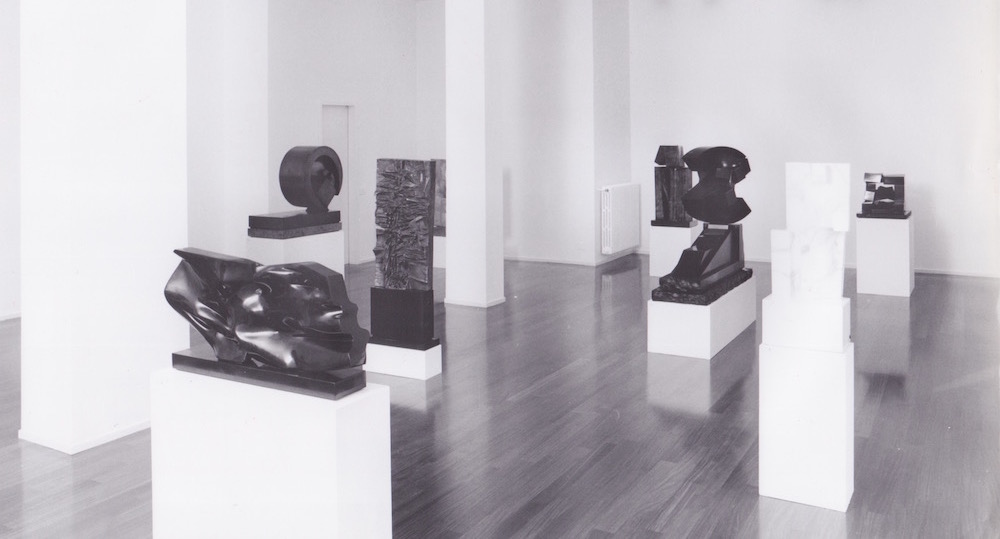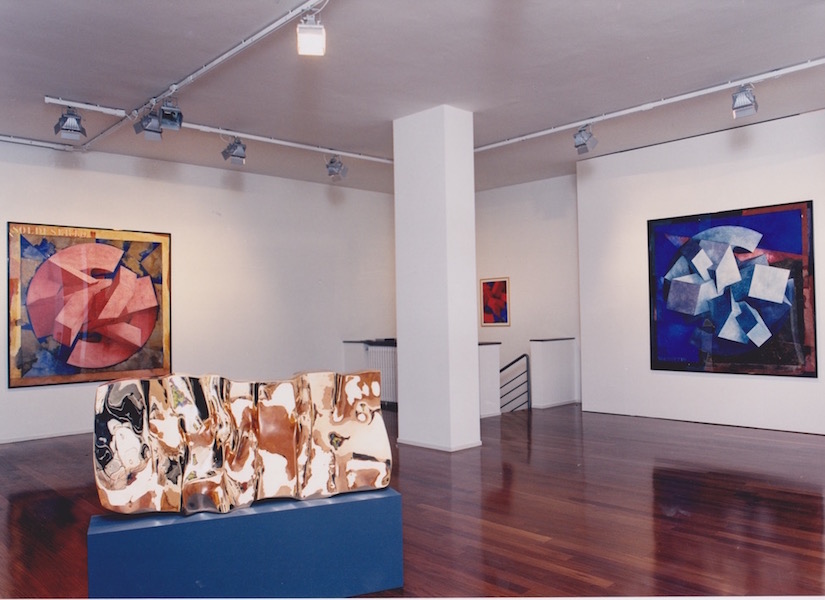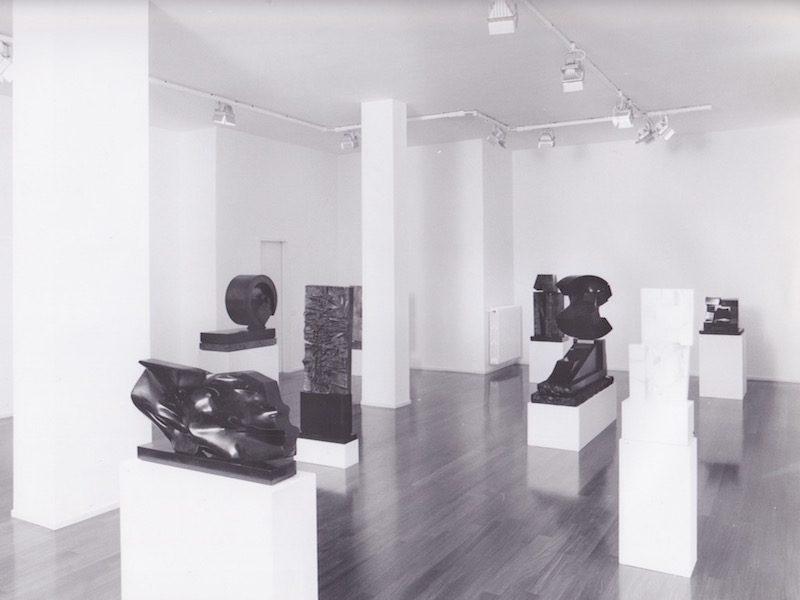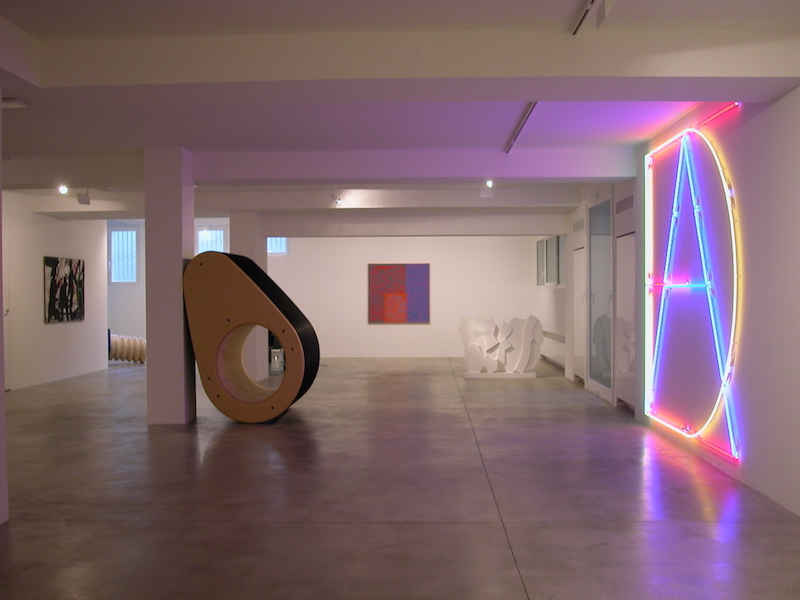GIÒ POMODORO
GIÒ POMODORO

Biography
Giò Pomodoro was born in Orciano di Pesaro in 1930 and passed away in Milan in 2002. In the ‘50s he moved to Milan with his brother Arnaldo, was contributor of “Gesto” magazine and took part in the exhibitions of “Gruppo Continuità”, supported by Giulio Carlo Argan, Guido Ballo and Franco Russoli. At the beginning of the ’60s Pomodoro developed the “Superfici in tensione” (“Surfaces in tension”), works based on the concept of empty space that makes the shape live as a spatial presence. The first works were made of fabric, then on fiberglass and polished or patinated bronze, finally from the ’70s on marble, a material traditionally used to sculpt the “full”. In those years, Pomodoro’s sculpture became monumental and mysterious, the grandeur of its dimensions referring to cultures and myths of ancient civilizations. The artist also designed squares and projects of urban redevelopment, such as the vast housing complex in Monza (piazza Ramazzotti) including functional elements such as benches, lighting and public green spaces. After the beginning in the ‘50s, from the second half of the 90s he went back to goldsmiths with renewed interest.
His solo exhibitions have been held in prestigious institutions, such as: Palazzo Ducale, Urbino and Museo del Gioiello, Vicenza (2018), Accorsi-Ometto Foundation, Turin (2017), Palazzo del Monferrato, Alessandria (2011), Villa Recalcati, Varese (2010), MACN, Monsummano Terme (2006), Auditorium Parco della Musica, Rome (2004), University of Bari (2003), Italian Institute of Culture, Cologne (2001), San Pietro Museum, Colle Val d’Elsa (2000), Veranneman Foundation, Brussels (1999, 1991), Palazzo del Monte di Pietà, Padua (1998), Palazzo Vecchio, Florence and Kunsthistorisches Museum, Vienna (1996), Yorkshire Sculpture Park, Wakelfield and the Querini Stampalia Foundation, Venice (1995), Genia Schreiber University Art Gallery, Tel Aviv (1993), Archaeological Museum, Milan (1992), Villa Renatico Martini, Monsummano Terme (1990), Rotonda della Besana, Milan (1989), Chiesa di S. Ambrogio, Milan and Palazzo dei Leoni, Messina (1987 ), Palazzo Ducale, Pesaro (1986), Palazzo Civico, Lugano (1985), Palazzo Lanfranchi, Pisa (1984), Ca’ Pesaro, Venice (1977), Emperor’s Castle, Prato and Musée d’Ixelles, Brussels (1976), Loggetta Lombardesca, Ravenna (1974), Palais des Beaux-Arts, Brussels (1963), Galerie internationale d’art contemporain, Paris (1959).
Several are the collective exhibitions and the public collections around the world that include his works. In 1994 Pomodoro won the price “Premio Internazionale Pietrasanta e la Versilia nel mondo”, in 2002 he was the first Italian to receive the “Lifetime Achievement Award in Contemporary Sculpture” and in 2004 his family donated to the Municipality of Forte dei Marmi the sculpture “La Figlia del Sole”, on the occasione of his solo show. Giò Pomodoro also took part in important international exhibitions: Cairo Biennial (1998), Venice Biennale (1984, 1978, 1964, 1962, 1956), Documenta, Kassel (1964, 1959). His collaboration with Galleria Fumagalli began in 1998 when a personal show was set up in the gallery, presenting sculptures and papers from 1958 to 1998. On the occasion, a catalog with a text by Marco Meneguzzo was published. In 2000, the gallery presented a second solo show accompanied by the book “Giò Pomodoro, l’opera disegnata”, a catalogue raisonné that included all his works on paper, with a text by Giovanni Maria Accame.
Biography
Giò Pomodoro was born in Orciano di Pesaro in 1930 and passed away in Milan in 2002. In the ‘50s he moved to Milan with his brother Arnaldo, was contributor of “Gesto” magazine and took part in the exhibitions of “Gruppo Continuità”, supported by Giulio Carlo Argan, Guido Ballo and Franco Russoli. At the beginning of the ’60s Pomodoro developed the “Superfici in tensione” (“Surfaces in tension”), works based on the concept of empty space that makes the shape live as a spatial presence. The first works were made of fabric, then on fiberglass and polished or patinated bronze, finally from the ’70s on marble, a material traditionally used to sculpt the “full”. In those years, Pomodoro’s sculpture became monumental and mysterious, the grandeur of its dimensions referring to cultures and myths of ancient civilizations. The artist also designed squares and projects of urban redevelopment, such as the vast housing complex in Monza (piazza Ramazzotti) including functional elements such as benches, lighting and public green spaces. After the beginning in the ‘50s, from the second half of the 90s he went back to goldsmiths with renewed interest.
His solo exhibitions have been held in prestigious institutions, such as: Palazzo Ducale, Urbino and Museo del Gioiello, Vicenza (2018), Accorsi-Ometto Foundation, Turin (2017), Palazzo del Monferrato, Alessandria (2011), Villa Recalcati, Varese (2010), MACN, Monsummano Terme (2006), Auditorium Parco della Musica, Rome (2004), University of Bari (2003), Italian Institute of Culture, Cologne (2001), San Pietro Museum, Colle Val d’Elsa (2000), Veranneman Foundation, Brussels (1999, 1991), Palazzo del Monte di Pietà, Padua (1998), Palazzo Vecchio, Florence and Kunsthistorisches Museum, Vienna (1996), Yorkshire Sculpture Park, Wakelfield and the Querini Stampalia Foundation, Venice (1995), Genia Schreiber University Art Gallery, Tel Aviv (1993), Archaeological Museum, Milan (1992), Villa Renatico Martini, Monsummano Terme (1990), Rotonda della Besana, Milan (1989), Chiesa di S. Ambrogio, Milan and Palazzo dei Leoni, Messina (1987 ), Palazzo Ducale, Pesaro (1986), Palazzo Civico, Lugano (1985), Palazzo Lanfranchi, Pisa (1984), Ca’ Pesaro, Venice (1977), Emperor’s Castle, Prato and Musée d’Ixelles, Brussels (1976), Loggetta Lombardesca, Ravenna (1974), Palais des Beaux-Arts, Brussels (1963), Galerie internationale d’art contemporain, Paris (1959).
Several are the collective exhibitions and the public collections around the world that include his works. In 1994 Pomodoro won the price “Premio Internazionale Pietrasanta e la Versilia nel mondo”, in 2002 he was the first Italian to receive the “Lifetime Achievement Award in Contemporary Sculpture” and in 2004 his family donated to the Municipality of Forte dei Marmi the sculpture “La Figlia del Sole”, on the occasione of his solo show. Giò Pomodoro also took part in important international exhibitions: Cairo Biennial (1998), Venice Biennale (1984, 1978, 1964, 1962, 1956), Documenta, Kassel (1964, 1959). His collaboration with Galleria Fumagalli began in 1998 when a personal show was set up in the gallery, presenting sculptures and papers from 1958 to 1998. On the occasion, a catalog with a text by Marco Meneguzzo was published. In 2000, the gallery presented a second solo show accompanied by the book “Giò Pomodoro, l’opera disegnata”, a catalogue raisonné that included all his works on paper, with a text by Giovanni Maria Accame.
Exhibitions
GROUP EXHIBITIONS
Exhibitions
GROUP EXHIBITIONS






Der Sport Willkommensbonus muss innerhalb von 30 Tagen nur 7-mal durchgespielt werden. Diese Kombination betrachtet unser Team als wirklich fair.
Für jeden Bonus ist eine Mindesteinzahlung von 20 € erforderlich.
Der Willkommensbonus verschafft neuen Spielern in diesem Casino bis zu 1.000 € Bonusgeld.
Es gibt zwei Willkommensboni als Teil des regulären Willkommenspakets, wenn Sie sich für ein Konto bei 30Bet Casino anmelden,
also lassen Sie uns über beide gehen. Sie werden ein solches Angebot
nicht einmal bei 30Bet Casino finden, was nicht überraschend ist, wenn man bedenkt, dass
das Casino nur 2 Boni anbietet. Der Schlüssel zu einer angenehmen Erfahrung
und problemlosen zukünftigen Transaktionen liegt darin, sich mit den Bonusbedingungen für alle Anreize, die Sie erhalten möchten, vertraut zu machen. Alle Spiele bei Casino – von Slots über virtuelle Tischspiele bis hin zum Live-Casino – verwenden zertifizierte Zufallszahlengeneratoren (RNG),
sofern es sich um digitale Spiele handelt. Als offiziell lizenziertes Online-Casino sorgt 30bet mit einer Glücksspiellizenz aus Curaçao
für ein vertrauenswürdiges und reguliertes Spielerlebnis.
Diese beinhalten oft Bonusgeld sowie Freispiele für ausgewählte Spielautomaten, um den Einstieg ins Casino zu erleichtern.
References:
https://online-spielhallen.de/buran-casino-cashback-ihr-weg-zu-verlorenen-einsatzen-zuruck/
Dazu gehören beliebte Tischspiele wie Baccarat und Casino Hold’em,
die für Spannung sorgen. Mit jeder Wette sammeln Sie Punkte, die gegen Boni,
Freispiele oder sogar Bargeld eingetauscht werden können. Die Freispiele sind für ausgewählte Slots
verwendbar und werden in täglichen Tranchen freigeschaltet.
Neukunden erhalten bei ihrer ersten Einzahlung einen großzügigen Willkommensbonus.
Von klassischen Fruchtslots bis hin zu modernen Video-Slots mit aufregenden Bonusfunktionen bieten wir für jeden Geschmack das passende Spiel.
Egal ob Tischspiele, Live Casino Spiele, Jackpot Slots oder
einen Roulette Spielautomaten.
Das schlägt sich darin nieder, dass unzählige Casinospieler aus aller Welt das Verde Casino als ihr liebstes Online Casino auserkoren haben.
Möchte man die App nicht herunterladen, kann man alternativ im mobilen Browser spielen. Ab dem zweiten Level wird Ihnen ein wöchentlicher Verde
Bonus mit Einzahlung angeboten, der mit Freispielen ergänzt wird.
Verde Casino bietet qualitativ hochwertige Glücksspiele und Sportwetten in Deutschland an. Willkommensbonus von 520 %
bis zu 1200 € + 220 Freispiele Die Möglichkeit, geräteübergreifend zu spielen und Slots im Demomodus zu testen, sorgt für zusätzlichen Komfort und Flexibilität.
References:
https://online-spielhallen.de/dolly-casino-login-ihr-einfacher-zugang-zu-spannenden-spielen/